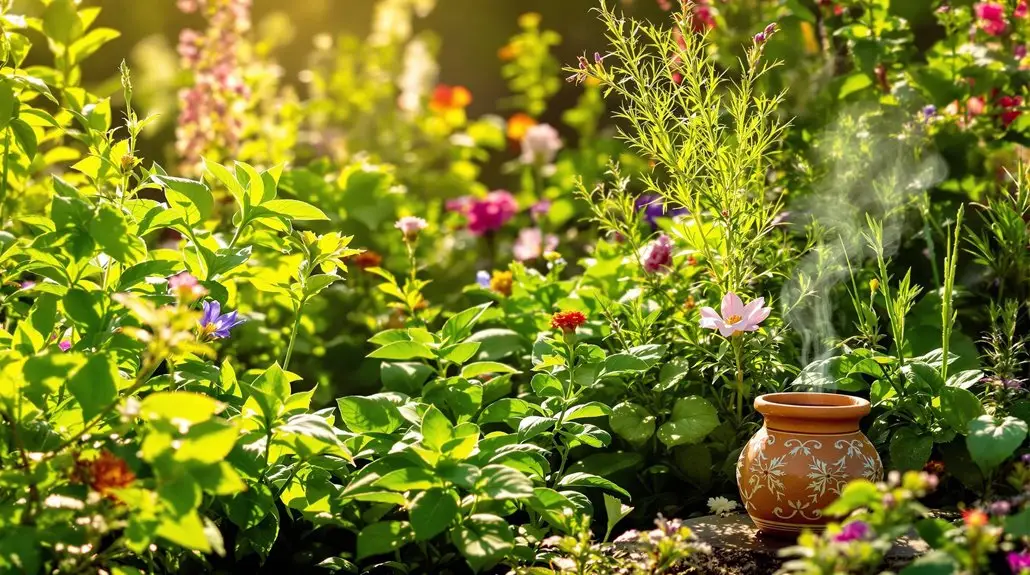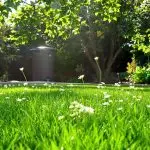To naturally deter grasshoppers in South Florida, you can try several effective strategies. Hand-picking grasshoppers during early mornings or late afternoons can help manage small infestations. Setting up traps around your garden’s perimeter and using trap crops, like tall grasses, attracts grasshoppers away from your prized plants. Attract birds and beneficial insects to your garden to create a healthy ecosystem that naturally controls grasshopper populations. Additionally, applying neem oil every 7-14 days can disrupt their life cycle. There are even organic baits that specifically target grasshoppers. Explore these methods further to find the best combination that works for you!
Key Insights
- Implement hand-picking and trapping techniques during early morning or late afternoon to manage grasshopper populations effectively.
- Attract natural predators like birds and beneficial insects by providing feeders, nesting boxes, and planting native flowers.
- Use trap crops, such as tall grasses, around the garden perimeter to divert grasshoppers from desired plants.
- Apply organic solutions like neem and horticultural oils to disrupt grasshopper life cycles and smother soft-bodied pests.
- Utilize Nolo Bait with Nosema locustae to target grasshoppers while being safe for beneficial insects in eco-friendly gardening practices.
Hand Picking Techniques
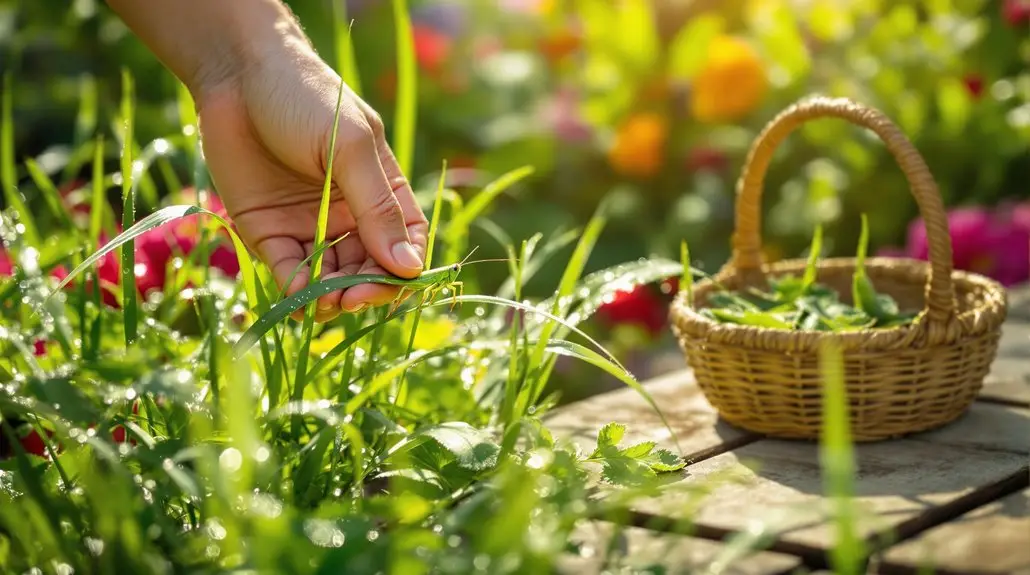
When it comes to managing grasshopper populations, hand picking can be an effective method you can employ. This technique allows you to directly address the problem, and it’s something you can do as part of a community effort. Start by identifying grasshopper habitats and their activity times. Early morning or late afternoon is ideal, as they’re less active during these hours. Be certain to wear protective gloves to avoid any skin irritation from their secretions. NaturePest offers natural pest control solutions that can complement your hand-picking efforts.
Prepare a bucket or container filled with soapy water for your collection. As you venture into your garden, keep an eye out for clusters of grasshoppers, especially near plants and garden edges. A broom or piece of cardboard can help you sweep them into the bucket. If you prefer a more hands-on approach, use a handheld net or pick them up carefully by hand. It’s important to note that grasshoppers consume a variety of plants, which means monitoring the health of your crops is essential during this process.
Once collected, submerge the grasshoppers in the soapy water to confirm they’re eliminated. Dispose of them in a sealed bag to prevent attracting other pests. Also, remember to clean your tools thoroughly after each use to maintain hygiene. Regularly repeating this process is key, especially after rainfall, which can draw grasshoppers to your garden.
Utilizing Natural Predators
Attracting natural predators to your garden can greatly help control grasshopper populations. By creating an inviting environment, you can encourage birds, insects, and even some mammals to join your garden ecosystem.
Here are three effective ways to attract these natural allies:
- Birds: Set up bird feeders and nesting boxes to welcome birds like sparrows, finches, and even larger ones such as chickens and guinea hens. These feathered friends love munching on grasshoppers and will help keep their numbers down. Additionally, maintaining biodiversity in your garden supports a wider variety of predators.
- Insect Allies: Encourage beneficial insects like wasps, ground beetles, and robber flies. You can plant native flowers to attract them, providing the food sources they need. These insects are particularly effective against grasshopper nymphs, helping to manage smaller infestations.
- Loggerhead Shrikes: If you want to target Eastern lubber grasshoppers specifically, consider attracting loggerhead shrikes. These unique birds are known for their hunting methods, which include decapitating and impaling grasshoppers on thorns or barbed wire—quite a gruesome yet effective tactic!
Implementing Trap Crops
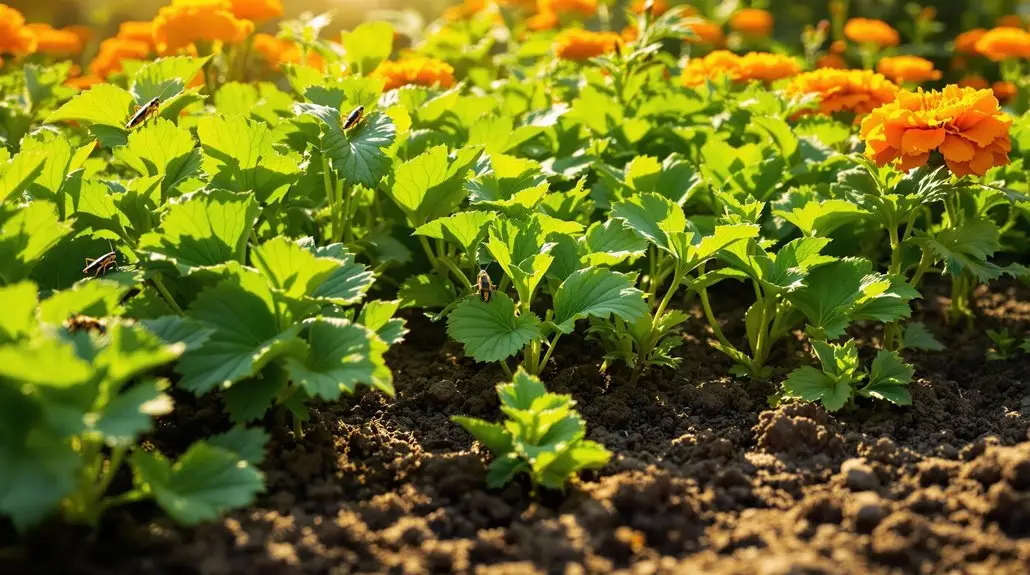
Utilizing natural predators is a great start for managing grasshopper populations, but you can further enhance your strategy by implementing trap crops. The idea here is simple: choose plants that grasshoppers find more appealing than the crops you want to protect. Tall grasses and lush green plants work well as trap crops, effectively diverting these pests away from your garden. Weeds can also do the trick, as grasshoppers are often drawn to them.
Position your trap crops around the perimeter of your garden to create a natural barrier. Make sure they’re accessible and visible, but keep them at a distance from your main crops to avoid attracting grasshoppers closer to your prized plants. Think about your garden layout to prevent trap crops from becoming a pathway straight into your garden. Additionally, consider using plant-derived oils to enhance the effectiveness of your trap crops, as they can help repel grasshoppers without harming the trap plants. Implementing this method aligns with the principles of Integrated Pest Management (IPM), which promotes combining various control strategies for effective pest control.
When it comes to maintaining these crops, avoid using pesticides. You want them to stay attractive to grasshoppers, so let them grow tall and remain unmowed.
Regularly check the health and allure of your trap crops, replacing or replenishing them as necessary. Keep the area around them free from other plants that might lure grasshoppers back to your main garden.
Effective Trapping Methods
Effective trapping methods can greatly reduce grasshopper populations in your garden. By employing a mix of DIY traps and natural predators, you’ll create a welcoming environment for your plants and fellow gardeners. Here’s how you can get started:
- Hand Picking and Physical Traps: For smaller infestations, hand-picking grasshoppers can be effective. Simply gather them in a bucket of soapy water to eliminate them. Adult Lubber Grasshoppers can grow up to 3 inches in length, making them easier to spot. You can also set up traps using clear glass panes or modified drink bottles, making sure grasshoppers enter but can’t escape. Additionally, cockroach bombs are not recommended for vehicles due to safety concerns, showcasing the need for safe and effective pest control methods.
- Bait Traps: Consider using organic insecticides like Nolo Bait, which specifically targets grasshopper nymphs. Place these bait stations early in the season near egg-laying areas. Remember to keep them dry by using small pipe sections or toilet paper rolls.
- Attracting Natural Predators: Enhance your garden by attracting birds like loggerhead shrikes and chickens. These natural predators can greatly help control grasshopper populations. Using biological baits like *Nosema locustae* can also be a strategic move. It’s important to note that mosquitoes and other pests may also share your garden space, so maintaining a balanced ecosystem is crucial.
Regularly inspect and maintain your traps to make certain they remain effective.
Combine these methods for a more integrated approach to pest management. By taking these steps, you’ll not only protect your garden but also foster a sense of community with fellow gardening enthusiasts who share your mission.
Happy gardening!
Neem and Horticultural Oils
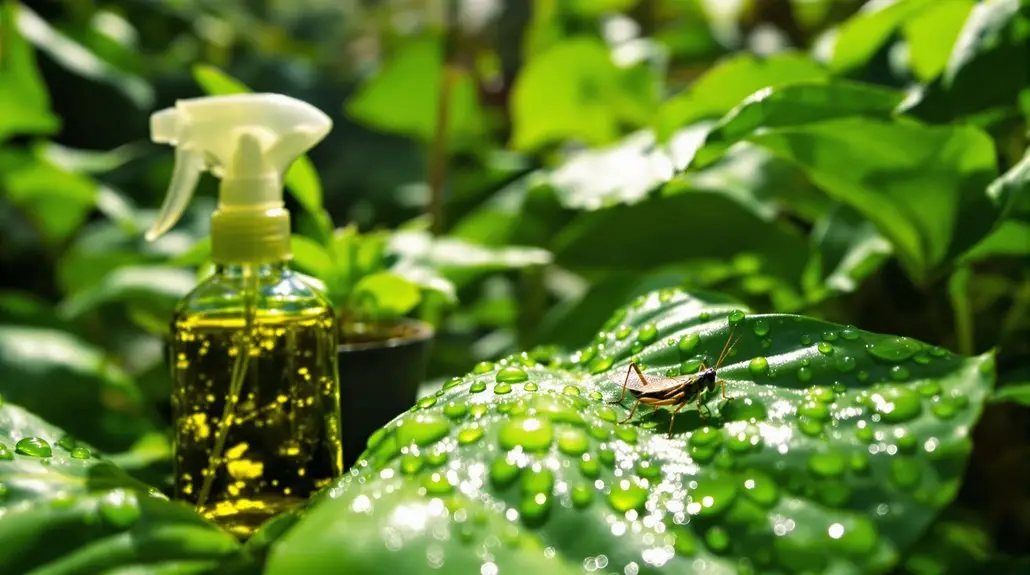
When dealing with grasshopper infestations, neem and horticultural oils can really step in to help protect your garden. These natural oils not only deter grasshoppers but are also harmless for the environment and beneficial insects.
Neem oil, derived from the seeds of the neem tree, contains azadirachtin, which disrupts the life cycle of pests, preventing their growth and reproduction. To use neem oil effectively, mix 3 teaspoons with 2 quarts of warm water and a ½ teaspoon of mild liquid soap. Spray this solution on the undersides of leaves and the soil, focusing on areas where grasshoppers tend to hide. You’ll want to repeat this every 7-14 days or after heavy rainfall for the best results. Additionally, neem oil acts as a fungicide, providing an extra layer of protection against plant diseases that may arise from pest infestations.
On the other hand, horticultural oils are another fantastic option. These oils work by smothering pests upon direct contact, making them highly effective against soft-bodied insects. When applying horticultural oils, guarantee thorough coverage of the affected areas, as they need to coat the pests directly. Just be cautious with your timing; spray early in the morning or late in the evening to protect our precious beneficial bugs.
While both neem and horticultural oils may not be as effective against tough lubber grasshoppers, they can still play an essential role in your overall pest management strategy. By incorporating these oils, you’re not only fostering a healthier garden but also forming a community of eco-conscious gardening enthusiasts.
Organic Baits and Insecticides
Organic Baits and Insecticides
After exploring neem and horticultural oils, it’s important to contemplate additional strategies for managing grasshoppers in your garden. Organic baits and insecticides can be game-changers, especially when you want to protect your plants while being eco-friendly. One standout option is Nolo Bait, which contains Nosema locustae, a naturally occurring fungus that targets grasshoppers. Choosing organic solutions aligns with the commitment to environmentally-friendly practices in pest control.
To effectively use organic baits and insecticides, consider these tips:
- Application Method: Sprinkle Nolo Bait around your garden or any infested areas. Use small containers like toilet paper rolls to shield the bait from moisture.
- Timing: Apply the bait early in the season to target young nymphs. Consistent application can lead to significant reductions in adult grasshopper populations. Additionally, monitoring grasshopper populations regularly is crucial for effective pest management.
- Safety First: Rest assured, organic baits like Nolo Bait generally won’t harm beneficial insects like earthworms. However, be mindful that they can affect crickets and mantids.
Frequently Asked Questions
How Do Weather Conditions Affect Grasshopper Populations in South Florida?
Weather conditions play a huge role in how grasshopper populations thrive. When you experience excessive rainfall, it can flood their habitats, impacting survival.
On the flip side, drought limits their food and water, causing population declines. High temperatures can speed up their reproduction, but extreme heat might be lethal.
Seasonal changes, like wet and dry periods, also shape their numbers, creating a dynamic environment that influences these fascinating creatures’ life cycles.
What Are the Best Times of Year to Control Grasshoppers?
So, you want to throw a grasshopper party? Well, it’s best to crash their shindig during the summer when they’re hatching!
You’ll want to gear up for control efforts in late spring or early summer, right before those little critters emerge.
Then, keep your eye out in late summer when they’re feeling especially bold.
Can Grasshoppers Damage Other Plants Besides Vegetables?
Yes, grasshoppers can definitely damage other plants besides vegetables. They love munching on young trees, shrubs, and even ornamental flowers.
If their preferred food sources are scarce, they might target non-plant materials too!
You’ll want to keep an eye on your garden and surrounding plants, especially during peak grasshopper seasons. Taking proactive measures can help protect your landscape and guarantee that your plants thrive despite these troublesome eaters.
Are There Any Plants That Naturally Repel Grasshoppers?
Yes, there are several plants that naturally repel grasshoppers. You might consider planting forsythia, which emits an almond-like scent, or rosemary, known for its strong aroma.
Crepe myrtle and sage also work well. You could create an herb garden with these aromatic plants to enhance their effects.
Additionally, planting marigolds and cilantro around your garden can help keep grasshoppers at bay, making your planting space more enjoyable and thriving.
How Can I Prevent Grasshoppers From Returning After Removal?
To prevent grasshoppers from returning after removal, you’ll want to clean up your garden, plant repellant species, and introduce natural predators.
You can also use barriers, like tall grass, to divert them and apply neem oil regularly.
Rotate your control methods to avoid resistance and keep monitoring for signs of reinfestation.
Defend Your Garden Naturally: Let NaturePest Help You Thrive!
In the battle against grasshoppers, you’re armed with nature’s own arsenal. By hand-picking, inviting natural predators, and employing trap crops, you’re not just protecting your garden—you’re nurturing a vibrant ecosystem. With neem oils and organic baits, you’re crafting a symphony of harmony, where every leaf flourishes. Embrace these methods, and watch your garden blossom like a canvas kissed by sunshine, free from the shadows of troublesome invaders.
Now, take the next step towards a thriving green oasis with NaturePest Holistic Pest Control. Our expert team is dedicated to helping you implement these natural strategies effectively, ensuring your garden remains healthy and vibrant. Don’t let grasshoppers take over your paradise—contact NaturePest today and let us help you cultivate a flourishing environment that is alive and free from pests! Your green oasis awaits!

